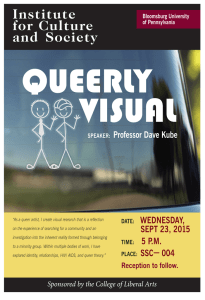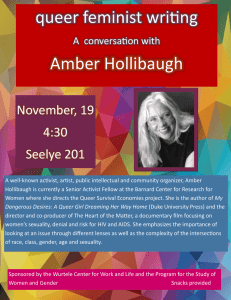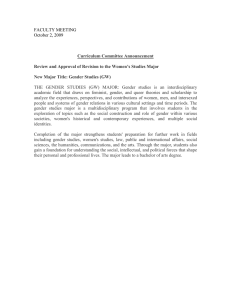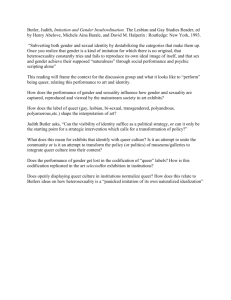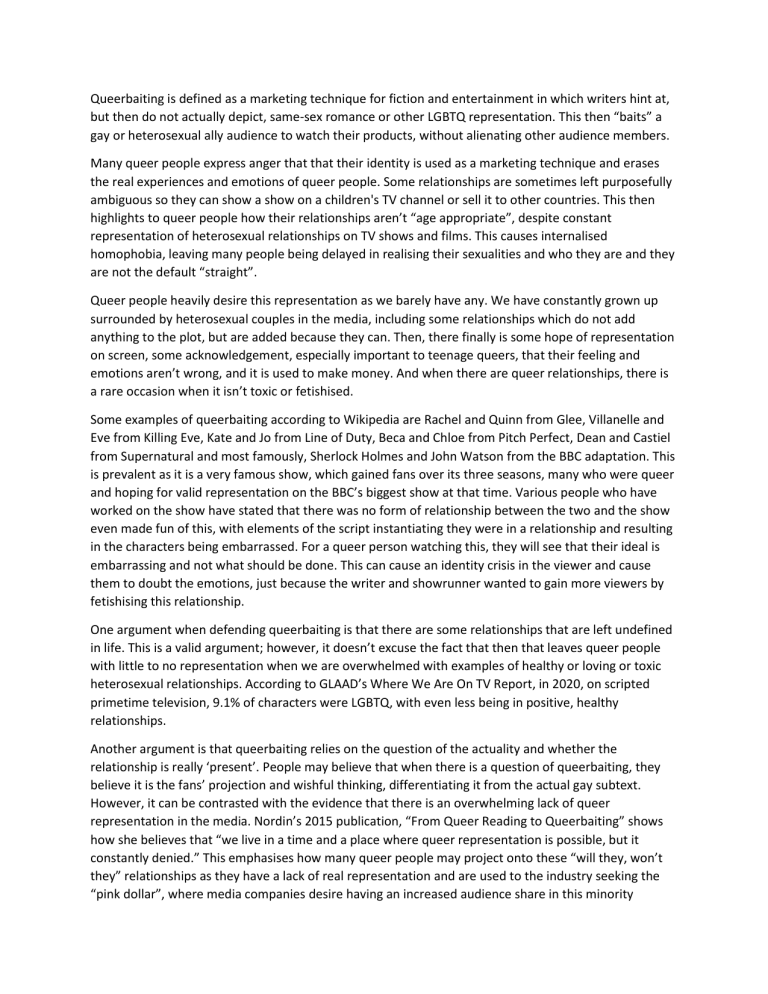
Queerbaiting is defined as a marketing technique for fiction and entertainment in which writers hint at, but then do not actually depict, same-sex romance or other LGBTQ representation. This then “baits” a gay or heterosexual ally audience to watch their products, without alienating other audience members. Many queer people express anger that that their identity is used as a marketing technique and erases the real experiences and emotions of queer people. Some relationships are sometimes left purposefully ambiguous so they can show a show on a children's TV channel or sell it to other countries. This then highlights to queer people how their relationships aren’t “age appropriate”, despite constant representation of heterosexual relationships on TV shows and films. This causes internalised homophobia, leaving many people being delayed in realising their sexualities and who they are and they are not the default “straight”. Queer people heavily desire this representation as we barely have any. We have constantly grown up surrounded by heterosexual couples in the media, including some relationships which do not add anything to the plot, but are added because they can. Then, there finally is some hope of representation on screen, some acknowledgement, especially important to teenage queers, that their feeling and emotions aren’t wrong, and it is used to make money. And when there are queer relationships, there is a rare occasion when it isn’t toxic or fetishised. Some examples of queerbaiting according to Wikipedia are Rachel and Quinn from Glee, Villanelle and Eve from Killing Eve, Kate and Jo from Line of Duty, Beca and Chloe from Pitch Perfect, Dean and Castiel from Supernatural and most famously, Sherlock Holmes and John Watson from the BBC adaptation. This is prevalent as it is a very famous show, which gained fans over its three seasons, many who were queer and hoping for valid representation on the BBC’s biggest show at that time. Various people who have worked on the show have stated that there was no form of relationship between the two and the show even made fun of this, with elements of the script instantiating they were in a relationship and resulting in the characters being embarrassed. For a queer person watching this, they will see that their ideal is embarrassing and not what should be done. This can cause an identity crisis in the viewer and cause them to doubt the emotions, just because the writer and showrunner wanted to gain more viewers by fetishising this relationship. One argument when defending queerbaiting is that there are some relationships that are left undefined in life. This is a valid argument; however, it doesn’t excuse the fact that then that leaves queer people with little to no representation when we are overwhelmed with examples of healthy or loving or toxic heterosexual relationships. According to GLAAD’s Where We Are On TV Report, in 2020, on scripted primetime television, 9.1% of characters were LGBTQ, with even less being in positive, healthy relationships. Another argument is that queerbaiting relies on the question of the actuality and whether the relationship is really ‘present’. People may believe that when there is a question of queerbaiting, they believe it is the fans’ projection and wishful thinking, differentiating it from the actual gay subtext. However, it can be contrasted with the evidence that there is an overwhelming lack of queer representation in the media. Nordin’s 2015 publication, “From Queer Reading to Queerbaiting” shows how she believes that “we live in a time and a place where queer representation is possible, but it constantly denied.” This emphasises how many queer people may project onto these “will they, won’t they” relationships as they have a lack of real representation and are used to the industry seeking the “pink dollar”, where media companies desire having an increased audience share in this minority subsection without actually delivering the actual minority representation. Cassidy Sheehan aligns “queerbaiting with the invalidation of queer identities” and argues that “even if writers have good intentions, queerbaiting is harmful to members of the queer community.” There are many examples in the music industry where queerbaiting has benefited an artist's career and made them icons in the gay community. Some of the most famous artists in the 80s purposefully left their sexuality ambiguous, such as David Bowie and Madonna to gain a loyal fanbase from these communities. More recently, artists such as Ariana Grande have been questioned over some of her lyrics and music videos are encouraging queer people to see it as representation when in reality it is fake. Then we get onto the side of the music industry fetishising LGBT relationships. Tatu, famous for All The Things She Said, are famous for being a faux-lesbian duo, despite one of the duo being unaccepting of her own gay son after profiting off of exploiting queer people. In conclusion, I believe that whoever we are, whether we are heterosexual, homosexual or undefined, we should all acknowledge the dangers that the lack of LGBTQ representation and queerbating has – especially on young queer people. I hope you all understand how tired queer people are of the constant representation of heterosexual relationships and have very little good examples of what they aspire to have in future.
